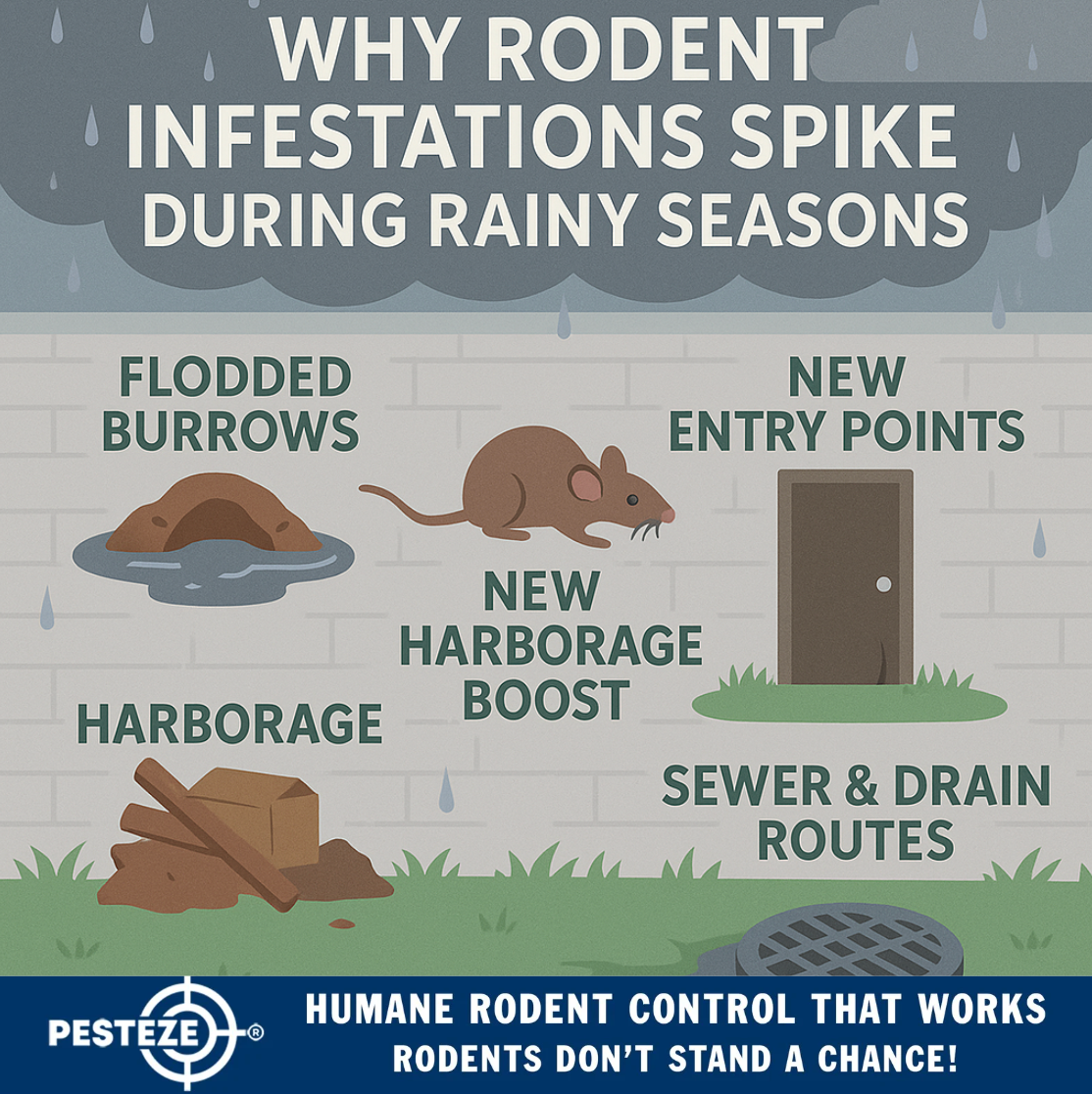WHY RODENT INFESTATIONS SPIKE DURING RAINY SEASONS

WHY RODENT INFESTATIONS SPIKE DURING RAINY SEASONS
SUMMARY
Heavy rain drives rodents from flooded burrows into homes and businesses in search of food, warmth, and shelter. Learn the science behind the surge, the warning signs to watch for, and the steps you can take right now to prevent a costly, unsanitary infestation.
FEATURES
-
Flooded Burrows: Saturated soil collapses nests, forcing rodents to relocate fast.
-
Food Displacement: Storms scatter food sources, pushing rodents toward buildings.
-
New Entry Points: Rain warps doors, cracks foundations, and opens gaps.
-
Harborage Boost: Wet debris piles and overgrown plants create perfect shelter.
-
Sewer & Drain Routes: Rising water levels drive rodents through pipes and drains.
-
Post-Storm Strategy: Inspection, exclusion, sanitation, and trapping to stabilize.
DESCRIPTION
Rainy seasons dramatically alter rodent behavior and habitat. When prolonged rain saturates the ground, burrows collapse and nesting material becomes waterlogged. Rodents, highly adaptable and resourceful, immediately move to higher, drier ground—often the nearest structure with dependable food and shelter. This sudden migration creates the noticeable spike many homeowners and facility managers experience after storms.
Weather damage also changes your building’s defenses. Water can warp wooden doors and frames, widen existing cracks in foundations, and loosen vent grilles or utility seals. Even a quarter-inch gap can admit a mouse; larger storm-related openings invite rats. After heavy rainfall, prioritize a perimeter check: door sweeps, thresholds, garage seals, utility penetrations, rooflines, and weep holes. Seal with steel mesh and exterior-grade sealants or metal flashing.
Food scarcity is another driver. Torrential rain scatters seeds, floods dumpsters, and disrupts typical outdoor foraging. Rodents follow scent trails to kitchens, stockrooms, pet bowls, and compost bins. Tighten sanitation: store food in rodent-proof containers, clean grease from grills, elevate and close trash, and schedule more frequent waste pickups during stormy weeks.
Landscape changes matter, too. Wind and rain create harborage—fallen branches, leaf piles, and soggy cardboard—near foundations and fences. Clear debris within 24–48 hours. Trim vegetation 12–18 inches from walls, raise woodpiles, and improve drainage so standing water doesn’t attract insects (a food source) or offer cover.
Sewers and drains become rodent highways when water rises. Install screened covers on floor drains, check backflow valves, and maintain tight-fitting lids on exterior cleanouts. In commercial settings, consider door air curtains at loading docks during peak season.
Finally, implement a post-storm IPM (Integrated Pest Management) routine: inspect high-risk zones (attics, crawl spaces, mechanical rooms), deploy snap or enclosed electric traps along runways, and use monitoring stations to gauge activity. If signs persist—fresh droppings, gnaw marks, rub trails—engage a licensed professional to design exclusion and population-reduction steps tailored to your site.
By understanding how rain reshapes rodent pressure and by acting quickly on exclusion, sanitation, and monitoring, you can turn peak season from a crisis into a controlled, manageable risk.
- Saharsh Bansal


Comments 0